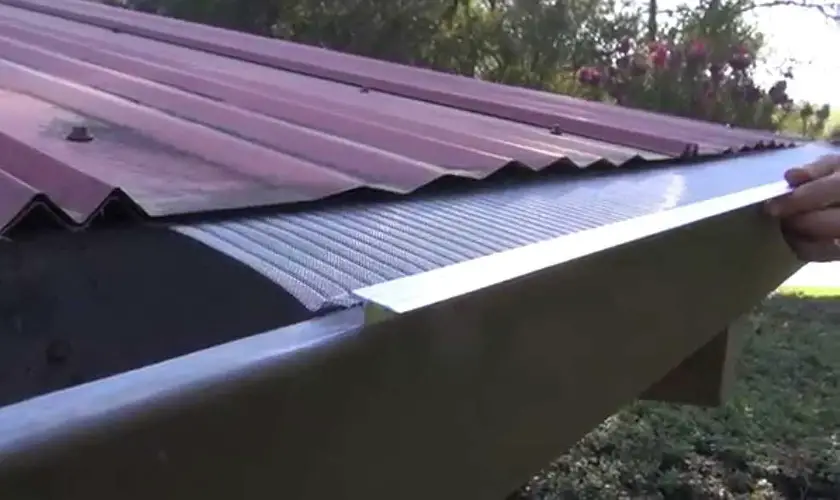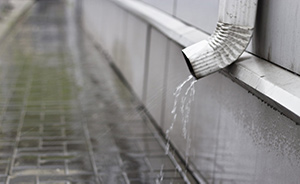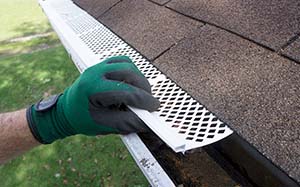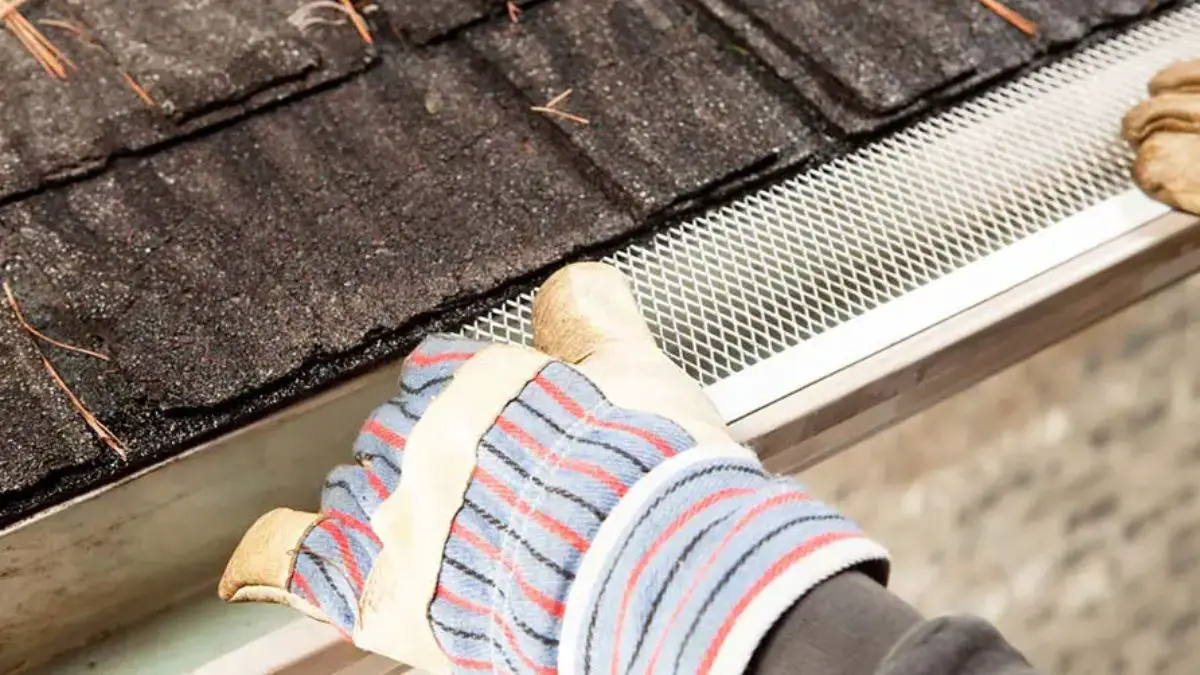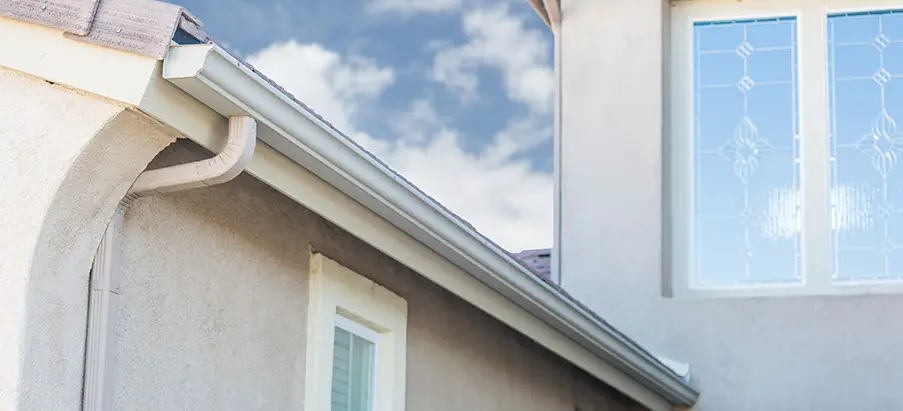
Can you build a house without gutters? Yes, you can. However, you would need to devise a different strategy to collect rainwater.
When rainwater cascades down a roof without gutters, it falls onto the ground around your home. It then erodes the soil and will start to flow toward the house rather than away from it.
That, in turn, eventually pushes water toward the lower parts of the walls, crawl space, floor, and basement, thus causing flooding, foundation issues, and damaged walls in the long term. A home without gutters can also have water-damaged siding and mold infestation.
Therefore, you must divert water from your home using a gutter system or another practical method. The article below discusses signs of poor drainage, how to make improvised gutters, and the different ways of diverting water from your home.
Recommended Reading: Are Gutter Guards Worth It or a Waste of Money? We Ask the Pros
Poor Rainwater Drainage: Signs and Problems
You may have a drainage issue if you spot giant water puddles a few hours after it stops raining in areas such as the yard. In addition, water in your driveway and stains on your siding and in the basement should also worry you.
1. Flooded Basements
A flooded basement is another sign that your home is not diverting rainwater as it should. And considering that it costs an average of $4,000 to clean a flooded basement, you should sit up and take notice of your situation quickly.
The longer you take to ignore the signs of poor rainwater drainage around your home, the more damage your property will experience. Over time, the exposure to water will make the foundation settle, which will strain your entire property.
2. Foundational Issues
Such a problem will appear as the patio, walls, chimney, and foundation crack. It will also show up in sticking doors, windows, and uneven floors.
And foundation issues are costly to fix too. For minor cracks, you will pay about $500. But if the situation is dire and there are significant issues, expect to pay upwards of $7,000 to sort them out.
3. Mold Infestation
Another nightmare is a mold infestation due to water damage on the siding and the resulting rot. First, your home will smell bad, which would make your house unpleasant to live in. But even if you don’t smell the mold, it poses many health risks.
Some of the health complications you can develop due to mold infestation include:
- Allergies
- Breathing problems
- Aspergillosis
- Lower respiratory tract problems in children
To get rid of mold, you must spend anywhere from $13.33 to $28.33 per square foot. So, the larger the area infested, the more money you will pay.
How Do You Make Homemade Gutters?
It’s safe to say that you need to divert rainwater away from home somehow. And the easiest way to do that is by installing a gutter system. The gutter system consists of the following:
- Gutter sections
- Downspouts
- Downspout elbows
- Hangers
- Pipe cleats
- End caps
- Mitered corner
- Ferrule
It’s safe to assume that complete gutter systems cost money. However, the cost of buying and installing the system will vary. It will depend on the size and design of your home and the type of material you opt to buy. It also depends on whether you install the gutters yourself. So, the price can range from $4 to $30 per linear foot of gutter installed.
For this reason, you may decide to save money by making gutters yourself. You can do that using:
- 3-inch PVC pipes are cemented together and cut in half before being mounted onto the roof eaves. The downspout can be made of uncut PVC pipe.
- Scrap or recycled metals bent into a U-shape and mounted onto the roof eaves. You can make the downspout from scrap metal fashioned as a tube.
- Metal pipes were cut in half and attached to the roof eaves. Either a PVC pipe or metal pipe can be used as a downspout.
How To Collect And Divert Water From Your Roof Without Gutters
It is worth noting that you don’t have to install a gutter system. It’s okay not to have gutters so long as you have other ways of collecting rainwater that can do just as good a job diverting it away from your home.
1. Site Grading
Site grading is an engineering process you can use to adjust the soil elevation and slope around your home. For example, if you have a rainwater drainage issue, you can redirect the water flow by ensuring your home stands on a higher ground than the surrounding area.
The general rule of thumb is you should grade your site to have a slope of 5%. That translates to a drop of 6 inches in height for every 10 feet away from your building. So, when it rains, the water cascades from the roof and away from your home, following the slope direction. As a result, you won’t need to worry about stormwater getting into your crawl spaces, basement, or foundation.
2. Install A Drain Tile System
Installing foundation drain tile systems is now part of many building codes. A drain tile system redirects surface water away from your crawl space or basement, so it doesn’t flood due to heavy rains or the rapid melting of snow.
Foundation drain tile systems are sometimes known as French drains after a Scottish wheat farmer, Henry French, who popularized the system to improve soil drainage. Other names for this method of draining water are weeping tile, footing tile, and perimeter drain systems.
Previously, drain tile systems were made of clay. But modern versions are made of corrugated plastic pipes or perforated PVC piping. The holes are usually on one side.
If you upgrade your home and install a foundation drain tile system, you can start by digging a trench around your foundation. It should be at least 24 inches deep and extend to the footing or bottom of your house’s foundation.
The trench must extend and slope downwards toward a selected drainage point, a swale, a storm sewer, a pond, etc. But it can also lead to a sump pump that will pump water away to a different area. The latter option works well in flatter areas.
The trench is then layered with gravel before the perforated piping is installed. Then it is covered by more gravel. Next, a fabric, such as gravel tar paper, landscape fabric, or nylon filter sock, is laid over the gravel to prevent silt from covering the piping holes. Then dirt is piled at the top of the trench.
When rainwater falls onto the ground, it follows the path of least resistance and gets absorbed into the network of pipes. Then it is channeled to the selected drainage point through gravity. That, in turn, prevents water from seeping through the foundation, crawl space, or basement.
3. Develop a Rain Garden
You may consider developing a rain garden to collect, divert, and manage rainwater from your roof and driveway. You can also channel water from your foundation drain tile system into a garden.
A rain garden, in this case, refers to a method of landscaping that enables you to plant flowers, shrubs, grass, etc., in a depressed section of your lawn. Such areas naturally tend to collect water from rain or melted snow.
If your home’s exterior is not sloppy, you can create the depressions yourself. For example, if you opted for site grading, you can assign the portion at the bottom of the slope as a rain garden.
The vegetation within the rain garden will filter the pollutants in the runoff water and help it percolate into the soil, thus recharging the groundwater. Also, the rain garden will help reduce soil erosion and attract insects, birds, and butterflies.
If you use native plant species, they will not need fertilizer and will be low-maintenance in the long term. In the end, these kinds of gardens can aid in improving the beauty of your surroundings while improving the drainage of rainwater.
4. Develop Dry Stream Beds
Dry stream beds are a form of landscaping consisting of a well-designed but functional trench or gully. They do an excellent job directing water away from your home into the ground or a larger drainage area.
The trenches are dug and designed to look like a normal riparian area but must follow the natural slope no matter how they meander across the property.
You can then put in a layer of sand or gravel, line it with stones and boulders on the side, and put your preferred riparian plants and grass along the edges of the trench. If you live in an area with a lot of rain, you should consider putting the stones into place.
When it rains, runoff water from your roof, drainage extensions, etc., will fall onto the dry stream beds and follow the designated course into a much bigger drainage point.
Such points may include a storm drain, rain garden, and wells. The stones and gravel will help water percolate into the ground rather than allow it to rush off and cause soil erosion or develop puddles.
5. Dig Swales
Swales are predominantly broad man-made ditches, which are relatively shallow and have gentle vegetated slopes and berms. They slow water flow, prevent puddles and flooding, and enhance soil drainage.
The vegetation you grow on the swale’s ditch, sides, and berms must withstand both dry and wet conditions. And it should not need regular maintenance that disturbs the soil. Also, consider plants that provide ground cover or have deep roots that spread. Examples of such plants include muhly and vetiver grass. You can also plant fruit trees and bamboo.
Swales can follow the contour of your surrounding areas’ slope or be built perpendicular to the existing slopes. They can also be dug slightly off the contour to help divert water in the direction you want it to go.
Regardless of which option best suits your needs, you must design the swales carefully so you have areas on which you can walk and drive even when it rains heavily. Of course, that also applies if you live on a farm. Also, you can build dry stream beds within the swales to beautify your lawn.
Consider developing diversion swales when you need to divert rainwater from your roof. In that case, you would build a swale from where your roof drains most of its water.
If the surrounding area has been graded, the swale can start from the bottom of the slope. Then you can dig it in the desired direction.
In addition, these swales can be an end-point for your roof. In such cases, you could channel water from features such as French drains into the swale. You can also use swales to divert rainwater into other drainage points, such as ponds or dams.
6. Build A Dry Well
Dry wells refer to underground structures which dispose of stormwater and surface runoff. The chamber sides have perforations to dissipate water, while the bottoms of the wells are usually filled with gravel to improve drainage and increase percolation.
As a result, dry wells are excellent for recharging groundwater. So, if the area surrounding your home has poor drainage, you can direct rainwater away from your building and into the dry well.
Drywells can also be used as drainage points for French drains, driveways, dry stream beds, and swales.
If you have gutters, you can divert downspout extensions into these wells or the areas near the wells. Also, you can build dry wells to absorb water flowing down the graded site near your house.
7. Construct A Water Reservoir
Constructing a water reservoir is an excellent idea for anyone who wants to harvest water and lives in an area with long periods of drought that sometimes experiences excessive rains. They can be in the form of ponds or dams.
It enables you to direct water away from your roof and lawns while ensuring that you have enough water for irrigation during the dry months. However, this option is only viable if you have a large area to work with.
You should consider constructing water reservoirs if your home is on a hill. You can also design your water reservoir to work with your French drains, dry creek beds, and swales, filling up or redirecting the overflow elsewhere.
8. Install A Sump Pump
A sump pump is a type of pump you can use to remove accumulated water within a sump pit through a discharge line, thus preventing flooding. The hole is usually dug within the lowest area of your home, usually within a basement or crawl space. However, you can also dig a sump pit outside your home, where water accumulates.
The sump pump can divert water into various areas. These include storm drains, streams, ponds, and dry wells. For this reason, they are great for collecting and directing water away from your home, thus minimizing their negative impact on your foundation.
Final Thoughts
While gutter systems are popular for collecting and diverting water from your home, you can do without them. However, it would help if you implemented other strategies, such as site grading and installing drain tile systems. You can also develop rain gardens or build swales, dry creek beds, dry wells, and ponds. And when everything else fails, there is always the sump pump.


